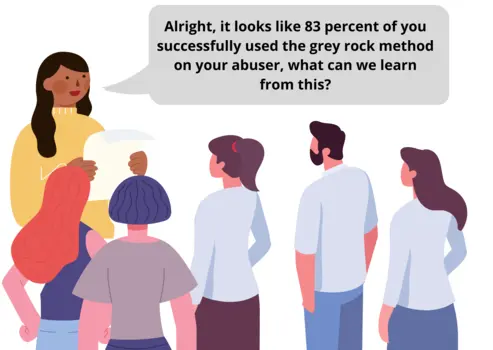To use the gray rock method, you must avoid having significant conversations with your abuser. When they use your vulnerabilities against you, you won’t engage. When they criticize you, you won’t try to defend or explain yourself. Your demeanor will always be very neutral around your abuser, like a boring gray rock.
You might be questioning the effectiveness of this method so we conducted a study among 375 survivors of all different types of abusive relationships who have used the gray rock method and found that the gray rock method was successful 83 percent of the time.
The whole point of the gray rock method is to limit the amount of validation, admiration, and reassurance, also known as narcissistic supply, that you provide to the abuser in your life to force them to move on and find another source of supply.
That said, there’s a lot that goes into both a successful and unsuccessful gray rock campaign so this article is going to guide you through all of the information that you need to know to successfully use the gray rock method on your abuser.

Why Does the Gray Rock Method Work so Well?
The gray rock method is optimized for abusers with narcissistic personalities so this section is going to guide you through the narcissistic realm to give you a comprehensive grasp of why the gray rock method works so well.
It’s believed by many qualified professionals that narcissism originates from an unhealthy or abusive upbringing with primary caregivers who are unavailable, unresponsive, and inconsistent.
This type of upbringing leaves children incapable of developing a realistic sense of self and with a ton of emotional inadequacies. This unhealthy or abusive upbringing that narcissists had didn’t give them the validation, admiration, and reassurance that a healthy upbringing would because their primary caregivers were unable to mirror their emotions, thoughts, feelings, and needs.
Under these circumstances the child will learn that their true identity isn’t good enough to be loved, acknowledged, and accepted by others. To manage this incredibly destabilizing belief, the child will begin to search their external environment for the validation, admiration, and reassurance they can’t get from their unavailable, unresponsive, and inconsistent primary caregivers.
This insecure and vulnerable search for validation, admiration, and reassurance is very dangerous. It teaches the child that they should prioritize their appearance in their external environment and compartmentalize their internal environment by suppressing their negative emotions to “manage” their fears of being rejected, abandoned, and unloved.
All this does is it creates a person with an incredibly unstable internal world that is hidden from others by a falsified identity that is designed to accumulate validation, admiration, and reassurance from their external world.

As you can imagine, this type of upbringing makes a narcissist’s sense of self extremely fragile and because of the fragility of their sense of self, they’re hypersensitive to any form of authenticity that contradicts their falsified identity.
Some of the characteristics of the falsified identity that they create are grandiosity, a sense of specialness/uniqueness, fantasies of unlimited success, power, and wealth, entitlement, and an excessive need of admiration.
It’s for this reason that the “authenticity” that could contradict their falsified identity could be as common as feedback, criticism, or even constructive criticism.
Why is this important to know?
The emotional inadequacies of a narcissist make them incapable of obtaining the amount of self-awareness required to fix a fragile sense of self so they rely on their ability to accumulate narcissistic supply instead. Unfortunately, the fragility of their sense of self means that they need A LOT of narcissistic supply to suppress their negative emotions.
The reason that the gray rock method works so well is because it significantly reduces the amount of narcissistic supply that the abuser so desperately needs, forcing them to move on to another source of supply or having all of their negative emotions that make them feel unlovable, rejectable, worthless, and abandonable bubble to the surface of their fragile sense of self.
Suggested Reading: How Do Narcissists React to the Gray Rock Method?

Why Does the Gray Rock Method Fail Sometimes?
In case you forgot, in our study among 375 survivors of abuse to determine the success rate of the gray rock method against abusers we found that 83 percent (311) of the participants reported that they were successful, leaving 17 percent (64) of the participants reporting that they were not successful.
We decided to conduct a follow up study with the 64 participants who reported that they were unsuccessful with the gray rock method to determine why and give our readers a more comprehensive grasp of the correct approach to going no contact with an abuser.
People Don’t Understand That the Gray Rock Method Must Be Applied To Every Interaction, Not Just the Negative Ones
We found that 95 percent (61 participants) of the 64 participants were unable to successfully use the gray rock method because they failed to understand that the gray rock method needs to be applied to every single interaction one has with an abuser, not just towards the negative ones.
At a quick glance, the gray rock method appears to be really simple. Avoid having significant conversations with the abuser. When they use your vulnerabilities against you, you won’t engage. When they criticize you, you won’t try to defend or explain yourself.
But upon closer examination, it becomes very clear that the gray rock method is much more complex than it seems. It’s important to remember that the purpose of the gray rock method is to protect your emotional stability from the harm your abuser causes.
The reason being that abusers are notorious for using intermittent reinforcement to distract you from your boundaries. Intermittent reinforcement is the delivery of a reward at irregular intervals.
The “reward” that an abuser will give their victim during intermittent reinforcement is a glimpse of the healthy, happy, and secure version of themselves they created by mirroring their victim in the beginning stages of the relationship.

Sadly, abusive relationships are so emotionally starved that the “reward” the abuser gives their victim actually triggers the victim’s brain’s reward center which floods their body with dopamine.
If you didn’t know already, dopamine is the same neurotransmitter that is released when humans abuse drugs like opiates, alcohol, nicotine, amphetamines, and cocaine. What this does to the victim of abuse is it turns the “reward” that their abuser gives them during intermittent reinforcement into their only known source of happiness.
They’ll develop an intense craving for the “reward” when they don’t have it, they’ll lose sight and control of themselves in the pursuit of it, and they’ll remain in the relationship, despite the negative consequences on their mental and physical health, because the “reward” they randomly receive from their abuser has become their only known source of happiness.
“Mike showed up unannounced to my parents’ house with a thoughtful gift that he made chronicling our time together. He put on an amazing display in front of my entire family. This was the performance of his life. He talked about how he had gone to therapy for his mistakes. He detailed how he had worked hard to change his habits, and he told us that he could not imagine a life without me, and on and on. There were tears, and his grand gestures succeeded in winning me over. Perhaps of even more importance to him, he succeeded in winning my family over as well.” Heather Kent, Registered Psychotherapist & Trauma Recovery Specialist In Her Book Heal from Your Narcissist Ex: The Ultimate Guide to Finding Safety and Sanity
It is very common for abusers to use different forms of intermittent reinforcement to trigger their victim’s sense of hope that the person they either love or loved is coming back when in actuality their emotional, passionate, and captivating demeanor is just another manipulative ploy. So, it is important that victims of abuse understand that the gray rock method needs to be applied to every single interaction that they have with their abusers, not just towards the negative ones.
What Should You Take Away From This Article?
For victims of abuse who can’t go no contact with their abuser, the gray rock method is a fantastic alternative. In our article How to Use the Gray Rock Method On a Narcissist we guide you this awesome technique and explain some of the emotions you’re going to feel when using the gray rock method on your abuser so be sure to check that out for more information!
About the Author

Hey, I’m Elijah.
I experienced narcissistic abuse for three years.
I create these articles to help you understand and validate your experiences.
Thank you for reading, and remember, healing is possible even when it feels impossible.
